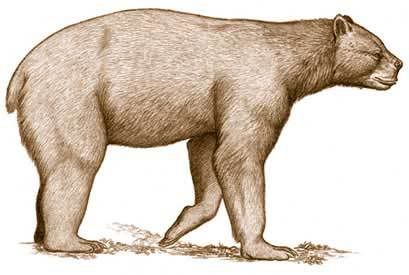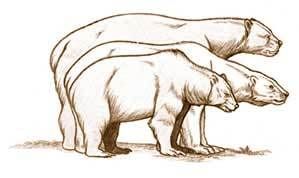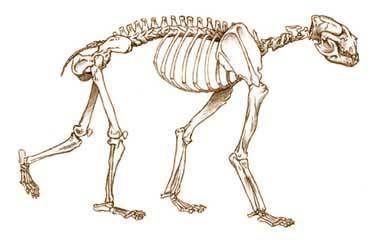|
|
Post by another specialist on May 26, 2008 6:20:37 GMT
The fossil record of South American short-faced bears (Ursidae, Tremarctinae) Abstract The present study includes a review of the geographic and stratigraphic distribution of short-faced bears (Ursidae, Tremarctinae) in South America. In addition, the authors discuss biogeographic hypotheses regarding the origin of South American tremarctines. The Tremarctinae subfamily is distributed exclusively in America, from Alaska to southern Patagonia. Its biochron comprises the temporal lapse between Late Miocene and recent times; the first record of Tremarctinae in North America corresponds to the Hemphillian and the last to the Rancholabrean. In South America, the first record corresponds to the Ensenadan. In the present day, it corresponds to the only living tremarctine, the ‘Andean Bear,’ but short-faced bears became extinct during the early Holocene. The extinction of short-faced bears in North and South America appears to have been approximately synchronous. Finally, the fossil record in South America indicates species turnover between the Ensenadan and Bonaerian, during which time the giant species Arctotherium angustidens was replaced by Arctotherium tarijense, Arctotherium bonaeriense, and Arctotherium vetustum (and probably Arctotherium wingei). www.sciencedirect.com/science?_ob=ArticleURL&_udi=B6VDS-4HF5KDT-3&_user=10&_rdoc=1&_fmt=&_orig=search&_sort=d&view=c&_acct=C000050221&_version=1&_urlVersion=0&_userid=10&md5=501d995beb5cdef50bc24802693321e7 |
|
|
|
Post by another specialist on May 26, 2008 6:22:25 GMT
Short-faced Bear Arctodus simus   The short-faced bear's size in comparison to the modern day grizzly (front) and polar bear (middle).  The short-faced bear was the largest and most powerful carnivore found at Rancho La Brea. Its size alone was probably enough to scare away any opposing animal. This bear stood over five feet tall at the shoulder, making it larger than the modern grizzly, brown, and polar bears of North America. When standing upright, the short-faced bear was over 11 feet tall and could weigh as much as 1,800 pounds. Its teeth suggest that this bear, like the modern grizzly or brown bears, was an omnivore with a diet dependent on food that was available. www.tarpits.org/education/guide/flora/bear.html |
|
|
|
Post by another specialist on May 26, 2008 6:23:46 GMT
An Exceptionally Large Short-faced Bear (Arctodus simus) from theLate Pleistocene(?)/Early Holocene of Kansas . . . . . . . . . . . . . . . . . . . . . . . . . . . . . . . . . . . . . . 97Katrina E. Gobetz and Larry D. Martin www.centerfirstamericans.org/crp/crp_pdf/2001_v18.pdf |
|
|
|
Post by another specialist on May 26, 2008 18:37:18 GMT
|
|
|
|
Post by surroundx on Nov 17, 2013 13:32:33 GMT
|
|
|
|
Post by surroundx on Sept 27, 2015 3:48:43 GMT
DeSantis, Larisa R. G., Schubert, Blaine W., Schmitt-Linville, Elizabeth, Ungar, Peter S., Donohue, Shelly L. and Haupt, Ryan J. (2015). Dental Microwear Textures of Carnivorans from the La Brea Tar Pits, California, and Potential Extinction Implications, pp. 37-52. In: Harris, John M. (ed.). La Brea and Beyond: The Paleontology of Asphalt-Preserved Biotas. Los Angeles, California: Natural History Museum of Los Angeles County, Science Series No. 42. 174 pp. |
|
|
|
Post by surroundx on Jan 6, 2017 12:49:05 GMT
|
|
|
|
Post by surroundx on Nov 28, 2017 13:22:12 GMT
|
|
|
|
Post by surroundx on Jan 7, 2018 10:16:42 GMT
Steffen, Martina L. and Fulton, Tara L. (In Press, 2017). On the association of giant short-faced bear ( Arctodus simus) and brown bear ( Ursus arctos) in late Pleistocene North America. Geobios. doi.org/10.1016/j.geobios.2017.12.001 [ Abstract] |
|
|
|
Post by surroundx on Jan 28, 2018 12:31:08 GMT
|
|
|
|
Post by surroundx on Oct 6, 2018 10:40:32 GMT
Czaplewski, Nicholas J., Rogers, Kyler J. and Russell, Clayton. (2018). Late Pleistocene vertebrates from Three-Forks Cave, Adair County, Oklahoma Ozark Hiughland. Journal of Cave & Karst Studies 80(2): 1-16. [ Abstract] |
|
|
|
Post by surroundx on Apr 24, 2021 2:58:28 GMT
|
|
|
|
Post by Melanie on Apr 26, 2022 10:00:43 GMT
|
|